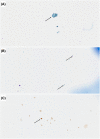Extraordinary linear non-enhancing brainstem leptomeningeal metastasis from lung adenocarcinoma: A case report
- PMID: 38751962
- PMCID: PMC11093894
- DOI: 10.1002/ccr3.8932
Extraordinary linear non-enhancing brainstem leptomeningeal metastasis from lung adenocarcinoma: A case report
Abstract
In patients with lung adenocarcinoma, angiogenesis-altering drugs can alter the appearance of leptomeningeal metastasis on magnetic resonance imaging (MRI) scans. In the ventral brainstem, this can manifest as a unique, linear, non-enhancing T2-hyperintense signal.
Keywords: adenocarcinoma; brain; lung; magnetic resonance imaging; metastasis; tyrosine kinase inhibitors.
© 2024 The Author(s). Clinical Case Reports published by John Wiley & Sons Ltd.
Conflict of interest statement
The authors declare that there is no conflict of interest, no affiliation or financial involvement with any commercial organizations, and no financial interest in the subject or materials discussed in the manuscript.
Figures


Similar articles
-
Band-Like Brainstem Lesion in a Patient With a History of Lung Adenocarcinoma.Cureus. 2022 Oct 26;14(10):e30726. doi: 10.7759/cureus.30726. eCollection 2022 Oct. Cureus. 2022. PMID: 36320789 Free PMC article.
-
Leptomeningeal enhancement in magnetic resonance imaging predicts poor prognosis in lung adenocarcinoma patients with leptomeningeal metastasis.Thorac Cancer. 2022 Apr;13(7):1059-1066. doi: 10.1111/1759-7714.14362. Epub 2022 Mar 3. Thorac Cancer. 2022. PMID: 35238486 Free PMC article.
-
Unusual magnetic resonance imaging findings of brain and leptomeningeal metastasis in lung adenocarcinoma: A case report.World J Clin Cases. 2022 Feb 16;10(5):1723-1728. doi: 10.12998/wjcc.v10.i5.1723. World J Clin Cases. 2022. PMID: 35211615 Free PMC article.
-
FLAIR hyperintensity along the brainstem surface in leptomeningeal metastases: a case series and literature review.Cancer Imaging. 2020 Nov 23;20(1):84. doi: 10.1186/s40644-020-00361-8. Cancer Imaging. 2020. PMID: 33228799 Free PMC article. Review.
-
Pediatric midline H3K27M-mutant tumor with disseminated leptomeningeal disease and glioneuronal features: case report and literature review.Childs Nerv Syst. 2021 Jul;37(7):2347-2356. doi: 10.1007/s00381-020-04892-0. Epub 2020 Sep 28. Childs Nerv Syst. 2021. PMID: 32989496 Review.
References
-
- Jänne PA, Baik C, Su WC, et al. Efficacy and safety of patritumab deruxtecan (HER3‐DXd) in EGFR inhibitor‐resistant, EGFR‐mutated non‐small cell lung cancer. Cancer Discov. 2022;12(1):74‐89. doi:10.1158/2159-8290.CD-21-0715 Erratum in: Cancer Discov 2022;12(6):1598. - DOI - PMC - PubMed
Publication types
LinkOut - more resources
Full Text Sources

